
The Never Summer Mountains are a mountain range in the Rocky Mountains in north central Colorado in the United States consisting of over twenty named peaks. The range is located along the northwest border of Rocky Mountain National Park, forming an S-turn in the continental divide between the headwaters of the Colorado River in Rocky Mountain National Park and the upper basin of the North Platte River. The range is small and tall, covering only 25 sq mi (65 km2) with a north–south length of 10 mi (16 km) with over ten distinct peaks rising more than 12,000 ft (3,700 m). The range straddles the Jackson-Grand county line for most of its length, and stretches into Jackson and Larimer county at its northern end. A panoramic view of the range is available from sections of Trail Ridge Road in Rocky Mountain National Park. One of the northernmost peaks, Nokhu Crags, is prominently visible from the west side of Cameron Pass.

Lead Mountain is a summit in Grand County, Colorado, in the United States. With an elevation of 12,546 feet (3,824 m), Lead Mountain is the 970th-highest summit in the state of Colorado. Lead Mountain was named in 1879 on account of its lead deposits.

Terra Tomah Mountain is a 12,718-foot-elevation (3,876-meter) mountain summit located in Rocky Mountain National Park, in Larimer County, of Colorado, United States. It is situated 13 miles west of the community of Estes Park, and 1.5 mile east of the Continental Divide. Terra Tomah Mountain is part of the Front Range which is a subset of the Rocky Mountains. Topographic relief is significant as the northeast aspect rises 3,300 feet above Forest Canyon in 1.5 mile. It is a prominent landmark viewed from Forest Canyon Overlook along the Trail Ridge Road.

Mount Cumulus is a 12,729-foot-elevation (3,880-meter) mountain summit in Colorado, United States.
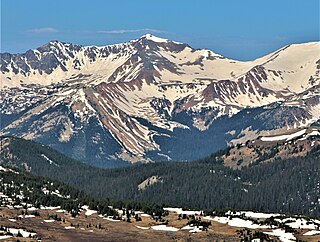
Mount Nimbus is a 12,721-foot-elevation (3,877-meter) mountain summit in Grand County, Colorado, United States.

Baker Mountain is a 12,410-foot-elevation (3,780-meter) mountain summit in Grand County, Colorado, United States.
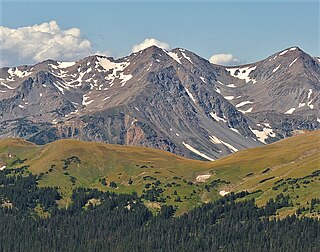
Howard Mountain is a 12,826-foot-elevation (3,909-meter) summit in Colorado, United States.

Chiefs Head Peak is a 13,577-foot-elevation (4,138-meter) mountain summit in Boulder County, Colorado, United States.
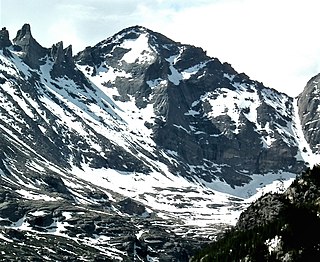
Pagoda Mountain is a 13,497-foot-elevation (4,114-meter) mountain summit in Boulder County, Colorado, United States.

Sprague Mountain is a 12,713-foot-elevation (3,875-meter) mountain summit on the boundary shared by Grand County and Larimer County, in Colorado, United States. It is set on the Continental Divide in the Front Range of the Rocky Mountains, and 12.5 miles (20.1 km) west of the community of Estes Park. Precipitation runoff from the mountain's east side drains into tributaries of the Big Thompson River and the west slope drains into headwaters of Tonahutu Creek which flows to Grand Lake. Topographic relief is significant as the summit rises over 1,900 feet above Tonahutu Creek in one mile. The peak is visible from Trail Ridge Road.

Mount Craig is a 12,007-foot-elevation (3,660-meter) mountain summit in Grand County, Colorado, United States.

Mount Mahler is a 12,497-foot-elevation (3,809-meter) mountain summit in Jackson County, Colorado, United States.
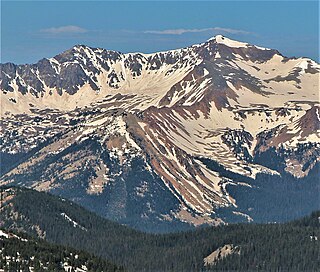
Mount Stratus is a 12,534-foot-elevation (3,820-meter) mountain summit in Grand County, Colorado, United States.
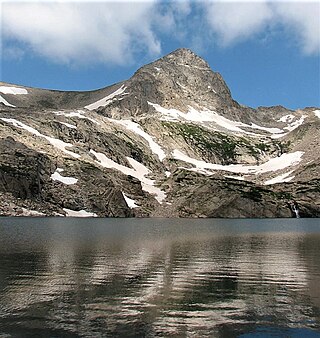
Mount Toll is a 12,979-foot (3,956 m) mountain summit on the boundary shared by Boulder County and Grand County, in Colorado, United States.

Pawnee Peak is a 12,943-foot (3,945 m) mountain summit on the boundary shared by Boulder County and Grand County, in Colorado, United States.
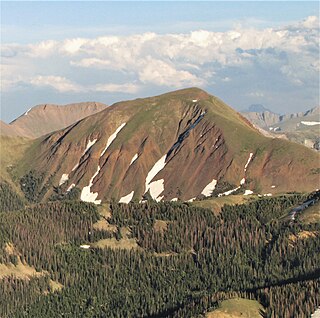
Lulu Mountain is a 12,217-foot-elevation (3,724-meter) summit in Colorado, United States.

Parika Peak is a 12,402-foot-elevation (3,780-meter) mountain summit in Colorado, United States.

Cascade Mountain is a 12,326-foot-elevation (3,757-meter) mountain summit in Grand County, Colorado, United States.

Never Summer Peak is a 12,452-foot-elevation (3,795-meter) mountain summit in Colorado, United States.

Green Knoll is a 12,297-foot-elevation (3,748-meter) mountain summit in Grand County, Colorado, United States.

























